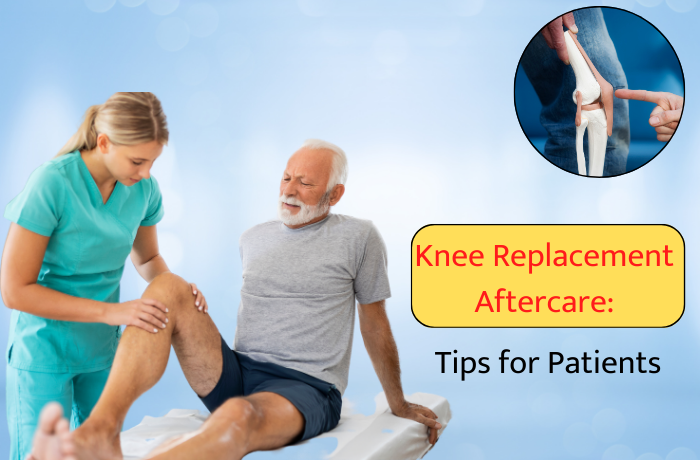Knee replacement surgery is a common procedure for people suffering from severe knee pain or damage. While the surgery itself is critical to restoring mobility, proper aftercare is just as important to ensure successful recovery. This blog will guide you through the essential steps and tips for managing your recovery after knee replacement surgery.
1. Why Aftercare is Essential for Knee Replacement Recovery
After knee replacement surgery, your body needs time to heal and adjust. A well-structured aftercare plan will help you regain mobility, reduce discomfort, and prevent complications. Following these steps can help you recover faster and get back to your daily activities.
2. Immediate care after surgery: What to do
After surgery, the first few days of recovery are crucial. Here’s what you should do to make the most of this time:
- Rest: It’s important to give your body the time it needs to heal. Avoid putting pressure on the operated leg and keep it elevated to reduce swelling.
- Wound care: Keep the surgical area clean and dry to prevent infection. Follow your doctor’s instructions for dressing changes and watch for signs of infection, such as redness or unusual drainage.
- Swelling management: Applying ice packs and keeping your leg elevated may help reduce swelling. Do this several times a day as advised by your healthcare provider.
3 . Taking these steps immediately after surgery is key to a smoother recovery.
Physiotherapy and exercise
Physiotherapy plays an important role in regaining mobility after knee replacement surgery. Your physiotherapist will guide you through specific exercises designed to strengthen the muscles around your knee and improve flexibility.
- Start early: Gentle movements can be started soon after surgery to prevent stiffness. Your physiotherapist will help you with simple exercises such as ankle pumps or gentle knee bends.
- Stick to a routine: Consistency is important. Follow the recommended exercise plan to improve mobility. Walking, stretching, and strengthening exercises will gradually restore your knee’s function.
- Use assistive devices: At first, you may need a walker or crutches to help you walk. Gradually, as your strength improves, you’ll be able to walk without assistance.
Following your physiotherapy plan is essential for faster recovery and regaining your freedom of movement.
4. Managing pain and discomfort
It is normal to experience some pain and discomfort after knee replacement surgery. However, there are ways to manage this effectively:
- Medication: Your doctor may prescribe pain-relieving medicines to help manage your discomfort. Make sure you take them as directed.
- Ice packs and elevation: Apply ice packs to the knee and keep it elevated to reduce pain and swelling.
- Managing stiffness: Stiffness is a common problem, especially in the early stages of recovery. Gentle stretching exercises can help improve flexibility and reduce discomfort over time.
Consistent pain management strategies will make the recovery process more comfortable.
5. Lifestyle changes to improve recovery
Certain lifestyle changes can significantly improve your recovery after knee replacement surgery:
- Diet: Eating a balanced diet rich in protein, vitamins, and minerals can help the healing process. Focus on foods such as lean meats, leafy greens, nuts and dairy products.
- Stay active, but be careful: While rest is important, it’s also important to stay active without overdoing it. Avoid putting too much pressure on the knee, but do light activities such as walking or gentle stretching.
- Daily adjustments: Modify your daily activities to avoid unnecessary stress on your knee. For example, avoid frequent stair climbing or lifting heavy objects during the first few weeks of recovery.
These simple adjustments can help speed healing and prevent complications.
6. Avoiding Complications
While knee replacement surgery is generally safe, certain complications may occur if proper care is not taken. Here are some signs to look out for and what you can do to prevent problems:
- Infection: Keep the surgical site clean and follow your doctor’s wound care instructions carefully. Signs of infection include increased redness, swelling or fever.
- Blood clots: Patients are at risk of developing blood clots after surgery, especially in the legs. Staying active by walking short distances, as recommended, can reduce this risk.
- When to see your doctor: If you have persistent pain, unusual swelling, or signs of infection, it’s important to see your doctor right away.
Following these steps and being aware of potential complications will help ensure a smooth recovery.
7. Consult an Orthopedic Doctor in Phursungi
If you have any concerns during your recovery or need expert advice on knee replacement surgery and aftercare, it’s important to consult an experienced orthopedic doctor. Dr. Rajeev Gawhale, an Orthopedic Doctor in Phursungi, has extensive experience in knee replacement surgery and can guide you through your recovery process, ensuring that you follow the right steps for optimal healing.
After knee replacement surgery, a thoughtful and structured aftercare plan is crucial to ensuring a smooth recovery. By following these tips and making the necessary lifestyle adjustments, you can improve your chances of regaining full mobility and living a pain-free life. Remember to seek medical advice if you experience any problems during your recovery.






